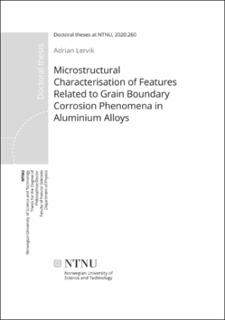Microstructural Characterisation of Features Related to Grain Boundary Corrosion Phenomena in Aluminium Alloys
Doctoral thesis
Permanent lenke
https://hdl.handle.net/11250/2678068Utgivelsesdato
2020Metadata
Vis full innførselSamlinger
- Institutt for fysikk [2650]
Sammendrag
Aluminium (Al) alloys are of great interest as components for the automotive and aerospace industries. These alloys have great mechanical properties and are lighter than their alternatives. Light alloys will effectively reduce the greenhouse gas emission and allow for longer driving range in electric cars. However, many of these alloys suffer from corrosion problems which prevents them from being used to their full potential. Finding ways to improve corrosion problems, while maintaining the mechanical properties, will enable Al alloys to become even more applicable. Understanding these corrosion properties better requires detailed understanding of the microstructure at the nanoscale. A tool enabling such studies is the transmission electron microscope (TEM).
Al alloys undergoes a processing route, involving exposure to different temperatures and mechanical deformation, before reaching its final shape. These stages will influence the corrosion behavior in the final product. The final stage produces large amounts of nanoscale secondary phases (precipitates) within the grains of the alloy. These provides the high alloy strength as compared to pure Al. Two Al alloys series have been investigated in this work. These are the Al-Mg-Si and Al-Zn-Mg alloys. These suffer from corrosion phenomena along the grain boundaries in the material. This is called intergranular corrosion and stress corrosion cracking.
The main findings involve new understandings concerning the precipitation behavior in both these alloys series. It is shown that corrosion can be reduces by altering the processing parameters, and that the fundamental reason for this is closely related to the precipitates. Methodologies for improved investigation of grain boundaries has been presented and are applicable to other material systems. In addition, a nearly 100-year-old riddle concerning the atomic structure of clusters forming in room temperature has been solved. The combined findings will be important in producing Al alloys with excellent mechanical properties and corrosion resistance.
Består av
Paper 1: Lervik, Adrian;Danbolt,T; Furu,R; Holmestad, R; Lunder, O. Influence of α-Al(Fe,Mn,Cu)Si phase particles on intergranular corrosion in extruded AA6005 aluminium alloy The final published version is available in Materials and corrosion - Werkstoffe und Korrosion https://doi.org/10.1002/maco.202011954 This is an open access article under the terms of the Creative Commons Attribution License (CC BY 4.0)Paper 2: Lervik, Adrian; Wenner, Sigurd; Lunder, Otto; Marioara, Calin Daniel; Holmestad, Randi. Grain boundary structures and their correlation with intergranular corrosion in an extruded Al-Mg-Si-Cu alloy. Materials Characterization 2020 ;Volum 170. https://doi.org/10.1016/j.matchar.2020.110695 Attribution 4.0 International (CC BY 4.0)
Paper 3: Marioara, Calin Daniel; Lervik, Adrian; Grønvold, Julie; Lunder, Otto; Wenner, Sigurd; Furu, Trond; Holmestad, Randi. The correlation between intergranular corrosion resistance and copper content in the precipitate microstructure in an AA6005A alloy. Metallurgical and Materials Transactions A 2018 ;Volum 49.(10) s. 5146-5156 https://doi.org/10.1007/s11661-018-4789-7
Paper 4: Lervik, Adrian; Thronsen, Elisabeth; Friis, Jesper; Marioara, Calin Daniel; Wenner, Sigurd; Bendo, Artenis; Matsuda, Kenji; Holmestad, Randi; Andersen, Sigmund Jarle. Atomic structure of solute clusters in Al-Zn-Mg alloys. Acta Materialia 2020 ;Volum 205. https://doi.org/10.1016/j.actamat.2020.116574 This is an open access article under the CC BY license (http://creativecommons.org/licenses/by/4.0/).
Paper 5: Lervik, Adrian; Marioara, Calin Daniel; Kadanik, Maria; Walmsley, JC; Milkereit, Benjamin; Holmestad, Randi. Precipitation in an extruded AA7003 aluminium alloy: Observations of 6xxx-type hardening phases. Materials & design 2020 ;Volum 186. https://doi.org/10.1016/j.matdes.2019.108204 This is an open access article under the CC BY license (http://creativecommons.org/licenses/by/4.0/).
Paper 6: Lervik, Adrian; Walmsley, John; Lodgaard, Lars; Marioara, Calin Daniel; Johnsen, Roy; Lunder, Otto; Holmestad, Randi. Stress Corrosion Cracking in an Extruded Cu-Free Al-Zn-Mg Alloy. Metals 2020 ;Volum 10.(9) https://doi.org/10.3390/met10091194 This is an open access article under the CC BY license (http://creativecommons.org/licenses/by/4.0/).
